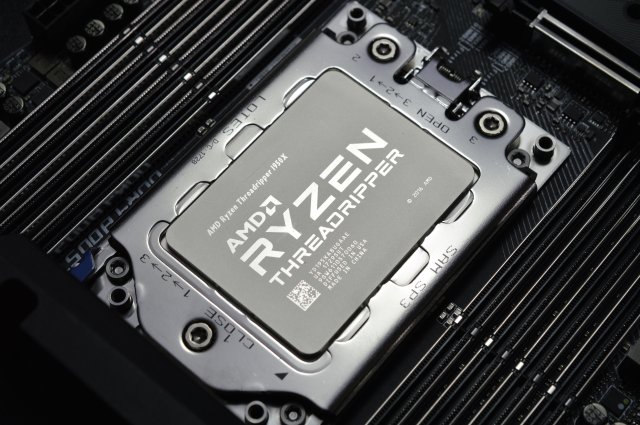
If you own an AMD Threadripper processor, by all means make it known by sending me a private message with your processor and motherboard models.
AMD Ryzen Threadripper 1950X
Cores: 16
Threads: 32
Base Clock: 3.4 GHz
Turbo Clock: 4.0 GHz
XFR Clock: 4.2 GHz
Cache: 41.5 MiB
Memory Channels: 4
ECC Support: Yes
PCIe 3.0: 64 lanes
TDP: 180 watts
Code Name: Whitehaven
Launch Date: 2017-08-10
Launch MSRP: $999
AMD Ryzen Threadripper 1920X
Cores: 12
Threads: 24
Base Clock: 3.5 GHz
Turbo Clock: 4.0 GHz
XFR Clock: 4.2 GHz
Cache: 39.125 MiB
Memory Channels: 4
ECC Support: Yes
PCIe 3.0: 64 lanes
TDP: 180 watts
Code Name: Whitehaven
Launch Date: 2017-08-10
Launch MSRP: $799
AMD Ryzen Threadripper 1900X
Cores: 8
Threads: 16
Base Clock: 3.8 GHz
Turbo Clock: 4.0 GHz
XFR Clock: 4.2 GHz
Cache: 20.75 MiB
Memory Channels: 4
ECC Support: Yes
PCIe 3.0: 64 lanes
TDP: 180 watts
Code Name: Whitehaven
Launch Date: 2017-08-31
Launch MSRP: $549
Note: I apologize for the stupid formatting used in the table below, but the forum software change has munged my ability to continue to use the old table format.
Owners List
Owner........... CPU..... Motherboard.................... Date.....
----------------------------------------------------------------------
Particle..........1950X....MSI X399 Pro Gaming Carbon AC....2017-08-17
Solarion..........1950X....MSI X399 Pro Gaming Carbon AC....2017-08-17
springs113........1950X....ASUS X399 ROG Zenith Extreme.....2017-08-17
ht_addict.........1950X....Gigabyte X399 Aorus Gaming 7.....2017-08-17
----------------------------------------------------------------------
farcodev..........1950X....ASUS X399 ROG Zenith Extreme.....2017-08-17
lifeisshort117....1920X....ASUS X399 ROG Zenith Extreme.....2017-08-18
ChronoBodi........1950X....MSI X399 Pro Gaming Carbon AC....2017-08-26
DeviousAddict.....1920X....Gigabyte X399 Aorus Gaming 7.....2017-08-27
----------------------------------------------------------------------
Fantasy...........1950X....ASUS X399 ROG Zenith Extreme.....2017-08-28
ajc9988...........1950X....ASRock X399 Taichi...............2017-08-28
Metuz.............1950X....ASUS X399 ROG Zenith Extreme.....2017-08-29
FlanK3r...........1950X....ASUS X399 ROG Zenith Extreme.....2017-08-29
----------------------------------------------------------------------
Sandbo............1950X....ASRock X399 Taichi...............2017-08-30
joeybuddy96.......1950X....Gigabyte X399 Aorus Gaming 7.....2017-09-01
dburd48778........1950X....ASUS X399 ROG Zenith Extreme.....2017-09-04
deadspeedv........1950X....ASUS X399 ROG Zenith Extreme.....2017-09-07
----------------------------------------------------------------------
Machiyariko.......1900X....ASUS Prime X399-A................2017-09-09
HeliosDoubleSix...1950X....MSI X399 Pro Gaming Carbon AC....2017-09-10
J-S-Q.............1920X....Gigabyte X399 Aorus Gaming 7.....2017-09-11
Ronsanut..........1950X....ASUS X399 ROG Zenith Extreme.....2017-09-14
----------------------------------------------------------------------
slipsand..........1900X....MSI X399 Pro Gaming Carbon AC....2017-09-14
Bm514.............1950X....Gigabyte X399 Aorus Gaming 7.....2017-09-16
Simmons572........1900X....ASUS Prime X399-A................2017-09-22
Emkq..............1950X....ASUS X399 ROG Zenith Extreme.....2017-09-25
----------------------------------------------------------------------
Atomicat..........1950X....ASRock X399 Taichi...............2017-09-25
Turok916..........1950X....ASUS X399 ROG Zenith Extreme.....2017-10-07
ITAngel...........1920X....ASRock X399 Professional Gaming..2017-10-12
oxijex............1950X....ASRock X399 Taichi...............2017-10-15
----------------------------------------------------------------------
sleeper119........1950X....ASRock X399 Taichi...............2017-10-26
Sphere07..........1950X....MSI X399 Pro Gaming Carbon AC....2017-10-30
johnzpa...........1900X....ASUS Prime X399-A................2017-11-19
ohms..............1950X....ASUS X399 ROG Zenith Extreme.....2017-11-25
----------------------------------------------------------------------
delerious.........1950X....ASUS X399 ROG Zenith Extreme.....2017-11-25
mypickaxe.........1950X....ASUS X399 ROG Zenith Extreme.....2017-11-28
4Strings..........1900X....ASUS Prime X399-A................2017-11-29
Dominican.........1950X....ASUS X399 ROG Zenith Extreme.....2017-12-01
----------------------------------------------------------------------
illirio...........1950X....ASUS X399 ROG Zenith Extreme.....2017-12-08
Ricky Bobby.......1950X....Gigabyte X399 Aorus Gaming 7.....2017-12-20
BMG238............1950X....Gigabyte X399 Aorus Gaming 7.....2017-12-27
OrionBG...........1950X....ASRock X399 Taichi...............2018-01-18
----------------------------------------------------------------------
KyadCK............1950X....Gigabyte X399 Designare..........2018-01-31
Arne Saknussemm...1920X....ASUS X399 ROG Zenith Extreme.....2018-02-15
alienalvan........1950X....Gigabyte X399 Aorus Gaming 7.....2018-02-28
blaket6199........1950X....Gigabyte X399 Aorus Gaming 7.....2018-03-02
----------------------------------------------------------------------
Archea47..........1950X....ASUS X399 ROG Zenith Extreme.....2018-03-18
cbehrend..........1950X....ASUS Prime X399-A................2018-04-24
Yamie.............1950X....Gigabyte X399 Aorus Gaming 7.....2018-05-22
bozfish...........1950X....ASUS X399 ROG Zenith Extreme.....2018-06-09
----------------------------------------------------------------------
papadoc...........1950X....ASRock X399 Taichi...............2018-06-21
EnderValentine....1950X....ASUS X399 ROG Zenith Extreme.....2018-06-28
jepz..............1920X....Gigabyte X399 Aorus Gaming 7.....2018-07-09
OsmiumOC..........1950X....ASUS ROG Strix X399-E Gaming.....2018-07-18
----------------------------------------------------------------------
Offler............1900X....ASRock X399M Taichi..............2018-09-01
ridn3y............1950X....Gigabyte X399 Aorus Gaming 7.....2018-09-05
tman480...........1900X....ASRock X399 Professional Gaming..2018-11-26
venura............1920X....ASRock X399 Taichi...............2018-12-05
----------------------------------------------------------------------
Quadrixx..........1950X....Gigabyte X399 Aorus Extreme......2019-01-15
NovaExclusives....2990WX...MSI X399 Pro Gaming Carbon AC....2019-01-24
TheMadHerbalist...1950X....Gigabyte X399 Aorus Extreme......2019-01-25
Andy Fox..........1950X....ASRock X399 Professional Gaming..2019-08-07
----------------------------------------------------------------------
HuggyBear.........1950X....MSI MEG X399 Creation............2019-08-14
Mektor............1950X....ASRock X399 Taichi...............2019-08-14
Mag the Ripper....2990WX...ASUS X399 ROG Zenith Extreme.....2019-09-06
Particle..........2990WX...MSI X399 Pro Gaming Carbon AC....2019-11-09
Air Coolers (Dedicated Designs)
Brand......... Model.............. Size............. MSRP
-----------------------------------------------------------
Arctic.........Freezer 33 TR........120 mm PWM........ 48..
Cooler Master..MA621P...............120 mm P/P PWM.... 65..
Noctua.........NH-U14S TR4-SP3......140 mm PWM........ 80..
Noctua.........NH-U12S TR4-SP3......120 mm PWM........ 70..
Noctua.........NH-U9 TR4-SP3........92 mm P/P PWM......70..
X2.............Eclipse Advanced 992 120 mm PWM........ 45..
Socket TR4 Motherboards
Brand...... Model....................... MSRP. Now.. Year
---------------------------------------------------------
ASRock......X399 Professional Gaming.....440.. 440...2017
ASRock......X399 Taichi..................340.. 350...2017
ASRock......X399M Taichi.................340.. 340...2017
ASUS........Prime X399-A.................350.. 300...2017
ASUS........ROG Strix X399-E Gaming......399.. 350...2017
ASUS........X399 ROG Zenith Extreme......550.. 500...2017
Gigabyte....X399 Aorus Extreme...........450.. 430...2018
Gigabyte....X399 Aorus Gaming 7..........390.. 360...2017
Gigabyte....X399 Designare EX............400.. 397...2018
MSI.........MEG X399 Creation............500.. EOL...2018
MSI.........X399 Gaming Pro Carbon AC....350.. 340...2017
MSI.........X399 SLI Plus................320.. 320...2018




